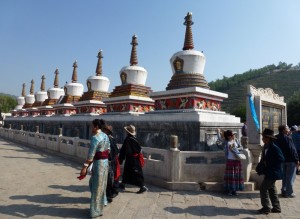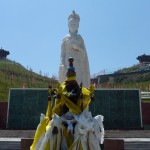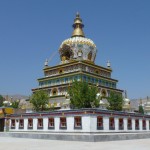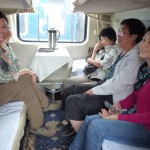Qinghai 青海 situated in the northeastern part of the Qinghai-Tibetan Plateau has a history of over 5,000 years. The Yellow River originates from the southern part of Qinghai while the Yangtze River and Mekong River both have their sources in its southwestern part. Durimg my 8-day stay in Qinghai, I visited Xining (the capital of the province), the Qinghai Lake, the Kumbum Monastery, Rebkong (a historical town) and Labrang (in the Gansu Province) before taking the train to Lhasa, Tibet.
Qinghai is one of the five Autonomous Regions in China with an area of 721,000 square kilometres and a GDP of US$20 billion (2010). It is multicultural and has a population of 5.6 million (Han – 54%; Tibetan – 21% and Hui – 16%).
August 9 (Tuesday): Kunming 昆明 – Xining 西宁
After spending four days in Kunming to recuperate from my trip to Laos, I flew to Xining. The flight only took two and a half hours and I arrived at Xining’s modern airport at 7:30pm. The airport bus is comfortable and cheap.
I met up with Brenda, my friend from Hong Kong who has a PhD from Oxford in Tibetan and Himalayan Studies. She is an excellent travel companion for this trip! We stayed in a family inn located in a modern high-rise building in the town centre. The owner, Mr. Kang 老康 of Hui origin 回族, is nice and helpful. We met two young Mainland couples and exchanged travel information on other parts of China. They just returned from a 2-day trip to the Qinghai Lake.
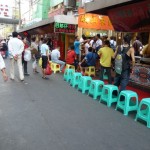 |
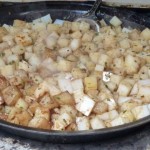 |
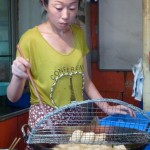 |
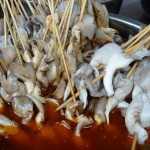 |
Xining is nice and cool in the summer. It is also famous for its street food – one can find all specialties from different parts of the Mainland. The local people enjoy dining out and there are a lot of eating stalls and restaurants in addition to bars. We visited two night markets. In the food street, there are many stalls selling kebab, spicy noodles, nuts especially walnuts which are in season. Brenda is a vegetarian and has a small appetite. I had a bowl of mutton blood sausage which is a local specialty. We brought peaches, apples and a melon and enjoyed the fresh and delicious fruits.
With the help of Mr. Kang, we planned an itinerary for a 6-day trip with a private car to visit the Qinghai Lake 青海湖, the Kanbula Geo-park 堪布拉地质公园, Rebkong 热贡/同仁 and Labrang 拉卜楞. The driver would pick us up on August 11 and take us to the train station on August 16 and the rent would be ¥600 a day.
August 10: Xining
Brenda and I were keen to take the famous train journey to Lhasa (1956km long). As tickets can only be purchased ten days before departure and we were not sure about the travel date, we decided to wait until we arrived in Xining. We spent the whole day running around to the train ticket sale offices and travel agents in order to buy a ticket for August 16. The ticket office told us there was no ticket available before August 18. Then a man passed by and said he could get us tickets and asked for¥1400 for one ticket. We know the fare for a berth/bed in a 4-berth compartment is around ¥800. Hence, we relunctantly agreed to pay an extra ¥600 in order to leave on August 16. When we got the ticket that evening, we were surprised to see the fare printed on the ticket was only ¥499 for a ‘hard bed’ in 6-berth/bed semi-open compartment. It is a disgusting rip-off!
In the afternoon, we spent two hours at the Qinghai Museum. The exhibits especially of pottery made some 4000-5000 years ago are superb. It is the first time I saw such well-preserved jars, plates and pots. The colours are gorgeous and the patterns are artistic with beautiful with waves, frogs, lines and curves.
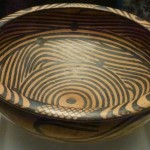 |
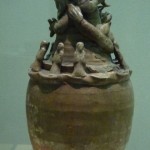 |
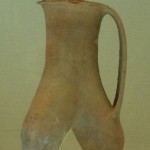 |
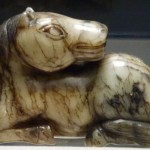 |
We met Zentai, a Tibetan from Rebkong in the late afternoon. He was introduced to us through Brenda’s friend in Hong Kong. He speaks English and runs a bar and travel services in Rebkong. As his driver would be in Xining the following day after taking some tourists to the Qinghai Lake, he suggested we come with his driver to Rebkong on August 12 and he would arrange our trip. I deliberately asked for a price which would cover the entire journey i.e. leaving from Xining on August 12 and returning to Xining on August 16. He offered a price of ¥2240. He seemed to be a nice guy and we agreed to change our plan in order to take his offer (This turned out to be a mistake and he became nasty when we were in Rebkong). When we saw Mr. Kang that evening, we told him about our change of plan and asked him to find us a driver for a day trip to the Lake. Mr. Kang was not annoyed and remained as helpful as ever.
August 11: Xining – Kumbum Monastery – Sun and Moon Mountain – Qinghai Lake – Xining (about 300 km)
We had a full day and visited three main attractions.
Kumbum Monastery 塔尔寺 is a sacred pilgrimage site second in importance to Lhasa. Tsongkhapa 宗喀巴, founder of the Gelugpa Order 格鲁派of Tibetan Buddhism is said to be born under the ‘Tree of Great Merit’ in 1357. In 1360s, his mother with assistance of others had a small temple built with a stupa on the site of his birthplace. In 1560, a small monastery was built. The 3rd Dalai Lama ordered a larger monastery be built after having a retreat there and the monastery was completed in 1583. A four-storied golden tilted temple has been built around the small temple/stupa. The ‘Golden Tree’ is the holiest place in Kumbum and this temple is revered in Tibet and Mongolia.
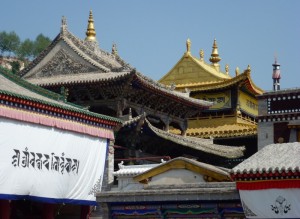 |
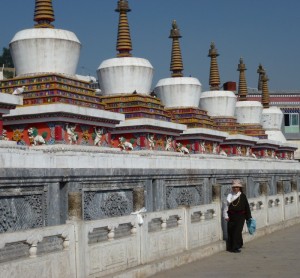 |
The Sun and the Moon Mountain 日月山 is a famous landmark in Qinghai. In 641 A.D. Emperor Taizong of the Tang dynasty 唐太宗 arranged Princess Wencheng 文成公主 to marry Tubo king 吐蕃王Srongtsan Gampo 松赞干布. The Emperor bestowed a sun and moon mirror to the Princess. Legends say that when the Princess arrived at this spot, she broke down and cried as she missed her family and was uncertain about her future. When her tears fell on the ground, they became a river immediately. She was afraid that the river would flow east and her father and relatives would see. She prayed and her feeling moved the Heaven who changed the river course. In order to show her resolution to promote the tie between the Han and the Tibetan and to settle in her new life in Lhasa, she broke the mirror and her entourage moved forward. The route the Princess had taken from Chang’an to Lhasa is now the famous ‘Ancient Tang – Tobu Route’ 唐蕃古道.
The Qinghai Lake 青海湖 is the largest lake in China with an area of 4,489 square kilometres. It is a saline lake located about 100km west of Xining at 3,205m above sea level. Its surface area decreased 11% from 1908 and 2000. An annual ceremony was conducted to the God of the Lake till 1949. The Lake is famous for bird-watching, wildlife and picturesque yellow oil flower fields. Unfortunately, the birds have already gone and we had to pay ¥10 per person to enter a field to take pictures of the oil flowers. We then arrived at a scenic area called Erlangjian 二郎剑 at 4 pm where we had to pay an entrance fee of ¥100 per person. We were frustrated when we were asked to pay another ¥10 for an electric car to take us to board a free bus to attractions several kilometres away. I could not understand why the free shuttle bus cannot pick up visitors right at the entrance. If they want visitors to pay ¥10 more for this short ride, the management can simply charge ¥110. There are few directional signs and no timetable of the free shuttle bus.
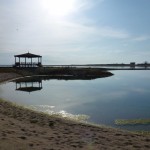 |
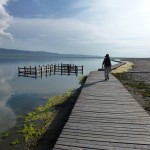 |
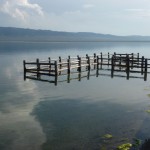 |
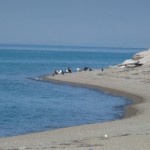 |
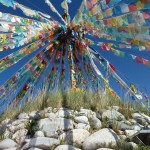 |
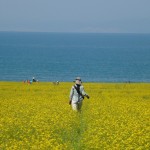 |
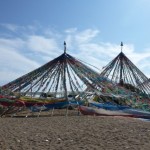 |
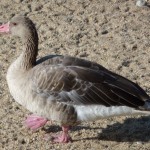 |
We spent two hours in the scenic area and visited the spot 祭海亭where the ceremony in honour of the God of the Lake was once performed. We watched some birds on the beach 观鸟亭. As we have many beautiful beaches in Hong Kong, it is difficult to get excited about the Lake (which is more like a sea!). Nonetheless, we enjoyed the scenery and tranquility just the same. We were the last group to leave the park and met up with our driver at 7pm. We raced back to Xining and we did not arrive at the hotel till 10pm. We had not eaten and Mr. Kang took us out for dinner at the night market.
August 12: Xining – Rebkong (about 300 km)
We met our Tibetan driver, Shawoja 沙吾加 at 9am and visited the Xining Mosque 西宁东关清真大寺, the largest one in Qinghai. First built in the Sung Dynasty in 1083, the mosque is known for its architecture which is a unique blend of Chinese, Tibetan and Islamic traditions. As it’s Friday, many locals arrived for praying. However, we could not enter as we are not Muslims.
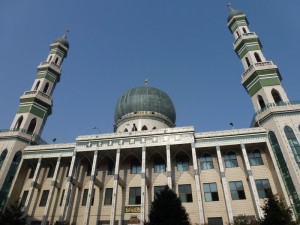 |
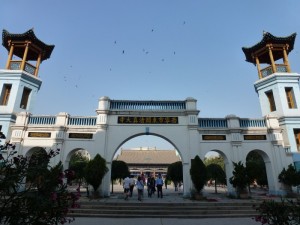 |
On our way to Rebkong, we visited several fantastic attractions. We saw the White Horse Temple 白马寺 on a cliff from the highway and asked the driver to take us there. It was first built over a thousand years ago and is said to have played a part in the revival of Buddhism.
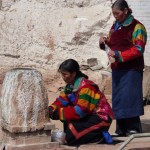 |
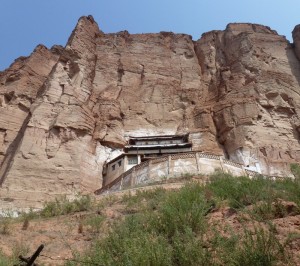 |
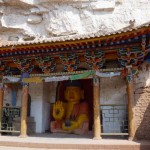 |
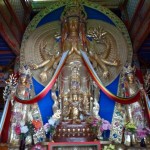
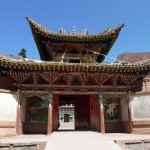 On the way to the Kanbula Geopark 堪布拉地质公园 (earth forests), we passed through the spectacular gorge Lijiaxia 李家峡 where there is a huge hydro-electricity plant, visited the Namkadzong (Sky Castle) Temple 南宗寺 and climbed to the Namkadzong Peak to visit a temple which affords a fantastic panoramic view of the earth forests. Once again the signage in the geopark is poor and we got lost on our way to a lookout pavilion.
On the way to the Kanbula Geopark 堪布拉地质公园 (earth forests), we passed through the spectacular gorge Lijiaxia 李家峡 where there is a huge hydro-electricity plant, visited the Namkadzong (Sky Castle) Temple 南宗寺 and climbed to the Namkadzong Peak to visit a temple which affords a fantastic panoramic view of the earth forests. Once again the signage in the geopark is poor and we got lost on our way to a lookout pavilion.
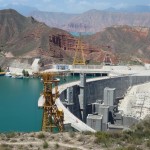 |
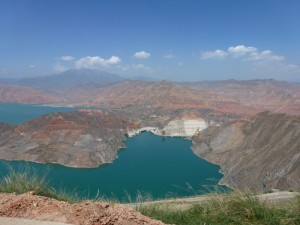 |
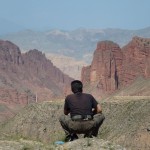 |
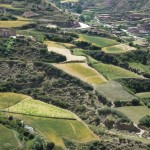
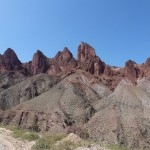 We left the geopark around 6:30pm and did not arrive in Rebkong till 9pm. We followed the Yellow River with beautiful views of the mountains and gorges. Unfortunately, it got dark and we missed the stunning scenery. Instead of taking us to our hotel, we were taken to Zentai’s café for dinner. Though we prefer simple Chinese food especially at such late hours, we ordered a pizza, yoghurt and beer out of courtesy. The pizza however did not arrive till 10pm. Brenda was so tired that we decided to take the pizza and eat it in our room. Zentai (who apparently was very proud of his cafe) must have thought that we were rude while we were tired and upset as well. We had to pay a lot for a pizza which we did not really enjoy. Things did not go well! The driver was told to wait for us without having any dinner. (Zentai is not a considerate boss!).
We left the geopark around 6:30pm and did not arrive in Rebkong till 9pm. We followed the Yellow River with beautiful views of the mountains and gorges. Unfortunately, it got dark and we missed the stunning scenery. Instead of taking us to our hotel, we were taken to Zentai’s café for dinner. Though we prefer simple Chinese food especially at such late hours, we ordered a pizza, yoghurt and beer out of courtesy. The pizza however did not arrive till 10pm. Brenda was so tired that we decided to take the pizza and eat it in our room. Zentai (who apparently was very proud of his cafe) must have thought that we were rude while we were tired and upset as well. We had to pay a lot for a pizza which we did not really enjoy. Things did not go well! The driver was told to wait for us without having any dinner. (Zentai is not a considerate boss!).
August 13: Sightseeing in Rebkong (about 10km)
Zentai wanted us to have breakfast at his café at 10:30am but it was too late for us. We ignored him and had delicious buns and congee in a small shop opposite our hotel. When the driver appeared at 10am, we asked him to take us directly to the places of attractions.
This region is called Rebkong 热贡 in Tibetan (Tongren 同仁 in Chinese) which is famous for its art and handicraft especially the making of thankas and clay statutes. The skills have been handed down by the Sengge gzhong people (i.e. Wutun 吾屯).
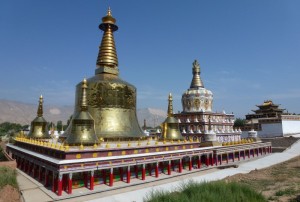 |
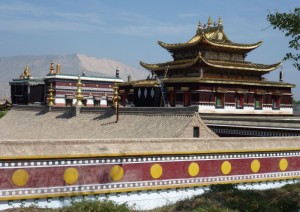 |
We first visited the Wutun Monastery 吾屯寺 which has more than 1000 years of history. Located at the foot of a mountain, it has a beautiful setting. Two huge stupas constructed outside the monastery in recent years afford superb views of the monastery and surrounding areas. Inside the monastery there are a Scripture Hall (经堂 (dukhang) and a Maitreya Palace 弥勒殿. As the 150 monks in the monastery are in retreat till mid August, the main halls are closed. We could only visit the newly constructed Avalokiteshvara Hall and the Hall for Tsongkhapa 宗喀巴. All the statutes are made with clay: they are enormous, serene, lively and beautiful.
We then drove across the valley to the western foothill to visit the Kalacakra Chorten 时论坛城塔 of the Gomari Monastery 郭麻日寺. The main monastery was closed as the monks are in retreat. What a pity!
Zentai ordered the driver to take us back to his café for lunch. Brenda was not happy with his being so dominating. At the café (filled with Western tourists) she purposely told Zentai that she had had enough of western food and would like to go out for local food. To Zentai’s dismay, we left and went to a traditional Tibetan restaurant. After a delicious lunch and a afternoon nap, we visited the famous Rongwo Gompa Monastery 隆务寺 which is one of the most important centres of Tibetan Buddhism.
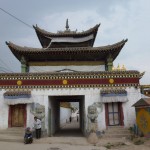 The monastery was founded in 1301 A.D. and has some 35 halls and three colleges. We spent over two hours wandering around this huge complex soaking in the atmosphere. We visited the Grand Sutra Hall 大经堂 and a few halls dedicated to Tsongkhapa, Manjusri 文殊, White Tara 白度母 and Maitreya 弥勒佛. In one of the halls, we saw the relics of founder of the monastery as well as the 10th and 70th of the head lama of the monastery. Unfortunately, we could not enter the 500- year old hall as the monastery is in retreat.
The monastery was founded in 1301 A.D. and has some 35 halls and three colleges. We spent over two hours wandering around this huge complex soaking in the atmosphere. We visited the Grand Sutra Hall 大经堂 and a few halls dedicated to Tsongkhapa, Manjusri 文殊, White Tara 白度母 and Maitreya 弥勒佛. In one of the halls, we saw the relics of founder of the monastery as well as the 10th and 70th of the head lama of the monastery. Unfortunately, we could not enter the 500- year old hall as the monastery is in retreat.
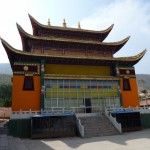 |
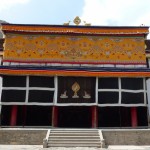 |
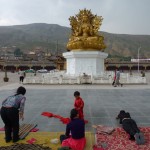 |
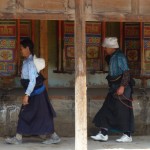 |
Zentai wanted us to go to at his café again. Brenda found the idea unwelcome (not pizza again!!), and she was tired and we preferred to have rice and noodle in a local restaurant. Zentai was upset (probably pretty hurt) because we did not appreciate his café)!
August 14: Rebkong – Xiahe Labrang Monastery, Gansu – Rebkong (about 250km)
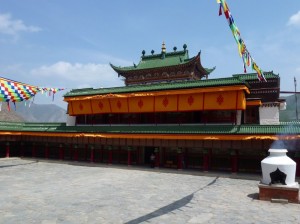 Labrang Monastery 拉卜楞寺 about 100km from Rebkong is one of the most important centres of Tibetan Buddhism and art. We wanted to set off at 8am. But Zentai ordered the driver to take us to see him to discuss our programme. He looked irritated as he had to get up early. The atmosphere of our meeting was intense. He demanded us to pay ¥2800 as he argued the price of ¥2240 originally agreed would only cover a 4-day tour. We were upset too as he was fully aware of our departure date and the agreed price would include all the places of interest. If the agreed sum of ¥2240 would be based on four days’ activities, we would have gone on our own to the three monasteries in Rebkong by taxi and on foot. Zentai shouted at the top of his voice that he had saved us some ¥20 a night at the hotel (i.e. we paid ¥120 instead of ¥140 a night) and accused us of trying to travel without paying i.e. “你到外面问一下,租我这一部车要¥ 1200一天的(!!!),我现在是在帮你们! 要玩,不掏钱!!”
Labrang Monastery 拉卜楞寺 about 100km from Rebkong is one of the most important centres of Tibetan Buddhism and art. We wanted to set off at 8am. But Zentai ordered the driver to take us to see him to discuss our programme. He looked irritated as he had to get up early. The atmosphere of our meeting was intense. He demanded us to pay ¥2800 as he argued the price of ¥2240 originally agreed would only cover a 4-day tour. We were upset too as he was fully aware of our departure date and the agreed price would include all the places of interest. If the agreed sum of ¥2240 would be based on four days’ activities, we would have gone on our own to the three monasteries in Rebkong by taxi and on foot. Zentai shouted at the top of his voice that he had saved us some ¥20 a night at the hotel (i.e. we paid ¥120 instead of ¥140 a night) and accused us of trying to travel without paying i.e. “你到外面问一下,租我这一部车要¥ 1200一天的(!!!),我现在是在帮你们! 要玩,不掏钱!!”
Both Brenda and I are reasonable and honest people; we take money lightly and do not want to take favours. We only want to be treated fairly and in a dignified manner and are very upset by his insulting remarks. We find him rude and arrogant and do not want to deal with him. We decided to stick with the agreed price and use his vehicle for four days. (As a result, we returned to Xining on August 15).
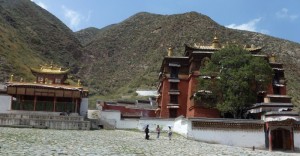
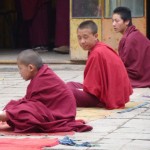 We finally set off at 9:30am and did not arrive in Labrang until 1pm. It was a hot day and we spent three and a half hours wandering around the impressive and enormous complex which has six schools, numerous halls and monastic quarters. But there is no map nor directional sign.
We finally set off at 9:30am and did not arrive in Labrang until 1pm. It was a hot day and we spent three and a half hours wandering around the impressive and enormous complex which has six schools, numerous halls and monastic quarters. But there is no map nor directional sign.
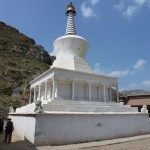 |
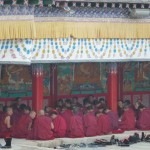 |
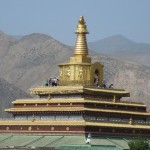 |
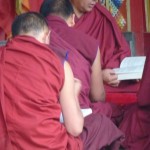 |
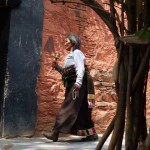 |
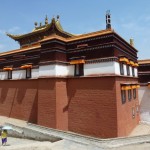 |
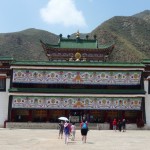 |
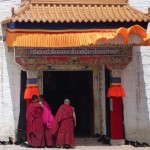 |
A lot of halls and temples are under renovation. I find the complex impressive in terms of size and architectural styles. Some buildings are in Tibetan styles, a few in Chinese styles and others in mixed styles. Once again we could not enter the main halls as the monks are in retreat.
We paid ¥20 in order to climb up the Gong Tang pagoda 贡唐宝塔 for a panoramic view. Then we discovered the 11th Panchen Lama was blessing his followers in the hall next to the pagoda. We rushed to the hall, lined up with the locals and presented him with white silk khatag 哈达. He touched my forehead giving me his blessing. An interesting experience!
We had a long day and arrived at Rebkong after 7pm.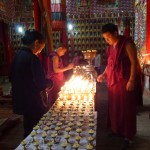
August 15: Rebkong – Xining ( about 300km)
There was a 3-day butter lamp lighting ceremony for 10,000 lamps in one of the temples in Rongwo Gompa Monastery. We therefore went there before leaving Rebkong. We met a female Buddhist from Shenzhen who comes every year for this. I found it atmospheric.
On the way back to Xining, we visited the Be’u mdo Monastery文都大寺 in Xunhua 循化. We were received by Yignyan (a high ranking scholar lama), a brother of Professor Dorje, a visiting scholar from Lanzhou whom Brenda met at Oxford three years ago. This monastery is also where the original monastery 祖庙 of the 10th Panchen Lama. Afterwards we visited the birthplace of the 10th Panchen Lama in Xunhua. The scenery along the route is beautiful and we arrived in Xining around 6pm.
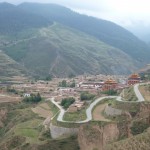 |
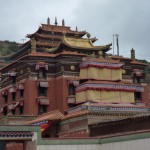 |
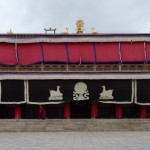 |
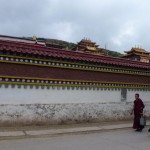 |
Shawoja, our driver, is in a difficult position. He has been nice to us but has to follow the instructions of his boss, Zentai. In any case, we gave him a good tip and wished him a safe drive back to Rebkong.
August 16 (Tuesday): Xining, Qinghai – Lhasa, Tibet by train青藏铁路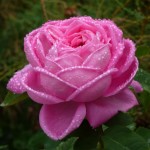
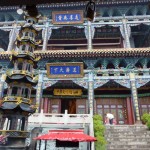 We checked out and visited two places of interest in the morning. We first went to a Taoist temple at the foothill of the north mountain. It has 1400- year history with a main temple for the three most revered gods in Taoism. There are some ten caves with statutes high up on the mountain. We were told four caves are open to visitors. But as it rained very heavily the day before, the path leading up to the caves was closed.
We checked out and visited two places of interest in the morning. We first went to a Taoist temple at the foothill of the north mountain. It has 1400- year history with a main temple for the three most revered gods in Taoism. There are some ten caves with statutes high up on the mountain. We were told four caves are open to visitors. But as it rained very heavily the day before, the path leading up to the caves was closed.
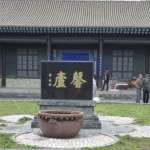
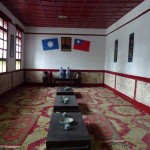 We then visited the official residence of Ma Bufang 马步芳公馆, a warlord in charge of the Qinghai and Tibet from 1930s to 1949. The residence completed within a year in 1943 has also been known as the Jade Mansion for many walls are covered in white jade tiles 昆仑白玉.
We then visited the official residence of Ma Bufang 马步芳公馆, a warlord in charge of the Qinghai and Tibet from 1930s to 1949. The residence completed within a year in 1943 has also been known as the Jade Mansion for many walls are covered in white jade tiles 昆仑白玉.
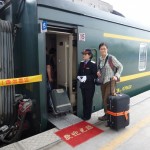 Brenda has never travelled in a long distance train and it’s quite an experience for her. But our journey did not start off well for several reasons.
Brenda has never travelled in a long distance train and it’s quite an experience for her. But our journey did not start off well for several reasons.
First, we find the Xining train station totally unsatisfactory. Though it is a new station, the design and facilities are poor and not user- friendly. Taxis have to drop passengers off some 400m from the entrance. Then passengers have to carry their luggage up a flight of staircase to the platform. If it is considered too costly to provide an escalator or a lift, there should at least be a ramp for people with heavy luggage or walking problems.
Second, we paid ¥1400 for a ticket with a printed fare is only ¥499. Apparently, tickets fall into the hands of some people/agents (properly or illegally) who then sell them to desperate travellers three or four times the original price. I have travelled on fast trains in China recently and have never encountered such a problem before. I had to use my Home visit card to buy a ticket from Qingdao to Jinan 济南 in Shandong. My data was recorded and I had to show my card before boarding the train. When I tried to purchase a ticket from Jinan/Tai’an to Beijing in June, I could see the seat availability situation from June 2 to 6 which was shown on TV screens in the Jinan railway station. I met other passengers on the train and found they all had to pay extra through all sorts of channels.
I was surprised to spot a couple of empty berths in the carriages with 4-berth compartments (which official fare per berth is about ¥800). How ridiculous and frustrating! The railway office has lost revenue while my money has gone illegally into someone’s pocket. I urge relevant authorities to tackle this problem. If the price for a berth in a 4-berth compartment should be ¥1000-1500, the authority should set the fare as such. I want to pay to the railway corporation so that the revenue can be used properly for the development and maintenance of the national railway system.
Third, we did not have a real chance to step out of the train to see or take pictures of the key landmarks. The train only stops for a few minutes or we were not allowed to leave the train. What a pity! I travelled on the Trans-Siberian Railway last September and found the journey more relaxing as I had more time to step off the train!
Fourth, the plateau scenery is nice but not as spectacular as I have imagined. Perhaps, this is an unfair remark. I have been lucky and spent several months travelling in Tibet, Nepal and Bhutan. Hence I have already seen a lot of stunning Himalayan landscape and scenery. Perhaps, if I had got what I paid for in a 4-berth compartment, I would have a nice journey and my views would have been totally different.
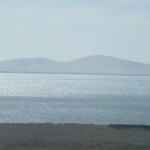 |
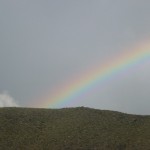 |
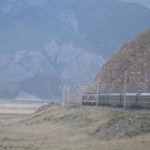 |
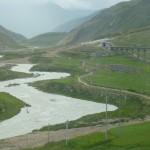 |
August 17 (Wednesday): Arrive at Lhasa Railway Station at 2:30pm
Remarks
It was my first visit to Qinghai. I find it very different from Tibet though both are important centres of Tibetan Buddhism. I have only seen a small part of Qinghai but find Xining, Rebkong, Kanbula Geopark, Lijiaxia and Rongwo Gompa Monastery interesting. Brenda’s knowledge about the Tibetan cultures has made my trip even more interesting. It’s unfortunate that most of the monasteries are closed in August when the monks are in retreat. Labrang in Gansu is most interesting and worth a second visit one day.
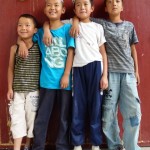 |
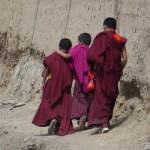 |
 |
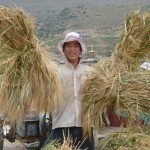 |
I have been looking forward to my visit to the Qinghai Lake and a journey on the Xining-Lhasa line. My expectations might have been too high and I am disappointed. I am appalled by the poor development at the scenic area at Erlangjian which is dirty with ugly buildings without proper sanitary facilities. In Europe, the lakeside is normally well-preserved with nice cottages and parks. I hope the relevant authorities can review the situation and learn from good examples in Europe. Proper planning is important and it is not too late to demolish the structures that are not up to standard and require new buildings with aesthetic appeals and proper sanitary facilities.
I wonder whether May-July might be a better season for first time visitors when there are more birds, wild flowers and yellow oil flowers. I may also have a better glimpse and appreciation of this wonderful province with its expansive grassland and wildlife and the sources of the three rivers if I travel by road.
In any case, I find the ticketing situation on the Qinghai-Tibet railway unacceptable. I am proud to see my motherland building the most difficult railway line to the ‘rooftop of the world’ which requires resolution, organisation skills, technology, financial and manpower resources. But there is problem with ticket sales which have seemingly providing opportunities for corruption and causing travellers much inconvenience and frustration. I hope the railway corporation and relevant authorities are aware of this problem and can tackle it without delay. They should also consider operating additional train services (i.e. to increase supply) or increasing fares (i.e. to control demand) during the peak season.
Qinghai has apparently benefitted from the increased railway traffic in recent years. Given its cultural and natural resources, Qinghai will attract more visitors in future as it is more diverse and mutli-cultural than the other four Autonomous regions i.e. Tibet, Xingjian, Inner Mongolia and Gansu. Though my first visit has been marred by my encounter with Zentai, I would still like to revisit it one day by road and to see the real Qinghai!


